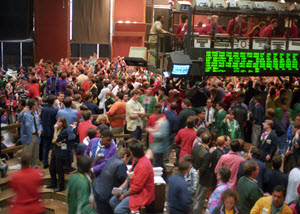THE OPEN
March beans: 1 1/2 lower
March meal: .10 lower
March soyoil: 3 lower
March corn: steady
March wheat: 2 higher
Prices opened as expected with further strength in wheat, which put in a new trading range high after the bell. Light profit-taking was noted in oilshare, with fund selling in corn. Weaker energies weighed on soyoil and corn, which pressured price action into the January WASDE. As was the price pattern in 2019, corn prices did tend to drift to new lows before major reports, keeping the same trading range pattern into 2020.
On the news front, White House Adviser Kudlow stated that the trade deal was still on for completion on Jan. 15.
At 11:00 the January WASDE / Quarterly Stocks report/ Winter wheat seedings were released as follows:
USDA Grain Reports Flash 01/10 11:04
U.S. PRODUCTION (Million Bushels) 2019-20
Jan Avg High Low Dec 2018-19
Corn 13,691 13,494 13,701 13,030 13,661 14,420
Soybeans 3,558 3,519 3,591 3,457 3,550 4,428
WINTER WHEAT ACREAGE (million acres) 2020-21
Jan Avg. High Low 2019-20
All Winter 30.8 30.7 32.2 30.0 31.2
Hard Red 21.8 22.1 23.1 21.6 22.5
Soft Red 5.6 5.1 5.6 4.6 5.2
White 3.4 3.4 3.5 3.3 3.5
QUARTERLY STOCKS (million bushels)
12/1/19 Avg High Low 9/1/19 12/1/18
Corn 11,389 11,416 11,660 10,926 2,114 11,937
Soybeans 3,252 3,179 3,379 3,023 913 3,746
Wheat 1,834 1,922 2,047 1,835 2,385 2,009
U.S. ENDING STOCKS (Million Bushels) 2019-20
Jan Avg High Low Dec 2018-19
Corn 1,892 1,753 1,960 1,479 1,910 2,114
Soybeans 475 432 520 310 475 913
Wheat 965 972 1,000 930 974 1,080
WORLD ENDING STOCKS (million metric tons) 2019-20
Jan Avg High Low Dec
Corn 297.8 297.3 301.0 290.5 300.6
Soybeans 96.7 95.7 97.5 91.7 96.4
Wheat 288.1 288.2 290.0 284.0 289.5
U.S. 2020-21 U.S. Winter Wheat Seedings Estimates
Friday's USDA
Estimate Average Range 2019-20
All Winter Wheat 30.8 30.7 30.0 - 32.2 31.2
Hard Red Winter 21.8 22.1 21.6 - 23.1 22.5
Soft Red Winter 5.64 5.1 4.6 - 5.6 5.2
White Winter 3.37 3.4 3.3 - 3.5 3.5
CORN: Production and yield higher but quarterly stocks were lower, down 5% vs. year ago. Harvested acres were 81.5 mln, vs. 81.8 mln acres prev. Exports were lowered to 1,775 mln bu from 1.850 mln bu, less than expected, while ethanol was left unchanged at 5,375 mln bu. The bullish component of the report was that there was higher-than-expected demand for corn for animal feed, with feed and residual numbers rising from 5,275 mln bu to 5,525 mln bu.
BEANS: Production and yield were higher but quarterly stocks were down 13% from year ago. Crush remained the same for 2019/20 at 2,105 mln bu, with exports at 1,775 mln bu, resulting in an unchanged carry-out of 475 mln bu. Harvested acres were unchanged at 75.0 mln. Brazil's bean crop remained unchanged at 123.0 mmt vs. Dec., while Brazil's Safras & Mercado estimated that a record production figure of 123.6 mmt could be reached.
WHEAT: Farmers planted 30.8 mln acres of winter wheat this fall, vs. 31.2 mln year ago, making the second lowest acreage on record. USDA said HRW is expected to total 21.8 mln acres, down 3% from 2019. KC wheat reacted with a market rally after the release of the numbers. SRW was up 8% from last year. On the supply and demand side, wheat exports were unchanged at 975 mln bu, while feed and residual increased from 140 mln bu to 150 mln bu. Ending stocks were slightly lower due to the increase at 965 mln bu vs. 974 mln bu prev. A lower quarterly stocks numbers was positive for wheat post report.
SOY
- The soy complex opened as expected with light selling in beans and soyoil and profit-taking in oilshare.
- March soyoil prices opened on the defensive with prices trending lower into the 11:00 report against a firmer meal market.
- Funds remain long over 100K Soyoil, which makes the market more vulnerable to a break, particularly when it appears that higher points of resistance are forming on the charts, as occurred this AM.
- March beans seemed to split the middle, staying in a trading range above major support at $9.35.
- March crush was firmer, trading back over 1.00c/bu to 1.01c/bu, while oilshare sold off to 36.27% into 11:00 stats.
- March soyoil prices finally triggered sell-stops before the report at 3440c, which resulted in a previous market gap-fill at 3429c.
- After the report, March beans fell once again to test key support at $9.35 where fund short-covering was noted.
- March meal prices stayed within its range of $295.00-$310.00, as more profit-taking in oilshare was noted on a weaker energies trade.
- Bean spreads broke after the release of the numbers with July/Nov trading out to 5c. Meal spreads were mostly steady with March/May trading out to $4.50 from $4.10.
- March soyoil futures continued weaker as the chart continued to find profit-taking on a bearish to neutral report, triggering sell-stops under 3440c that took prices to the 20-day moving average of 3422c, where prices put in momentary stabilization. However, the price action and fund long of 100K implies that further corrective action towards 34c or below could be coming.
GRAINS
- Funds continued to buy wheat/sell corn, backed by technical trading into the 11:00 report.
- March corn rallied into its 100-day moving average at $3.87 but stopped short from moving higher, which kicked off a round of technical selling once again.
- Before the report, corn spreads were weaker with July/Dec trading out to 3 1/2c from 2 3/4c, vs. values that were closer to even in previous weeks.
- March wheat continued to be well bid, moving into new highs before the release of the report close to $5.70 at $5.68 1/2. Funds continue to build new length in wheat.
- March wheat/corn traded higher again, up to 1.85c from morning values of 1.77c.
- Fund index re-balancing continued to strengthen KC values over Chicago. During the period from Jan. 8-13, the funds are expected to sell 8400 contracts of Chicago wheat and buy 10,359 contracts of KC as they re-weight their portfolios. After the release of the report, sell-stops were triggered as the downside of corn fell to new weekly lows with prices down to $3.76 1/2 in March. However, the question posed at the start of the day (would funds use a bearish report to cover?) seemed to be answered as prices also traded higher, seeming to suggest that there is good value in March corn at $3.75.
- Corn spreads were also weaker post data with July/Dec trading out to 5 1/4c, but also finding some buying interest at that level.
- March wheat values seemed to cover an entire trading range in one day, with a new high in March at $5.68 1/2, with a test of key support of $5.55.
AT MIDDAY THE MARKETS ARE AS FOLLOWS:
HI LO
March beans: 1 higher 9.46 9.35 1/2
March meal: 2.60 higher 303.80 300.30
March soyoil: 30 lower 3489 3422
March corn: 2 higher 3.86 1/2 3.76 1/2
March wheat: 1 higher 5.68 1/2 5.55 3/4
March canola: .40 higher 485.00 482.40
OUTSIDE MARKETS
The Dow traded either side of even from the start of the trading session, but down 69 pts at midday. Crude oil breaks to $58.85/barrel with the US dollar lower at 97.29.
CLOSING COMMENTS
The report was more bearish than expected but the price action was more interesting than expected as well. It seems as though traders and commercials took advantage of the corn break to get something priced, which created a two-sided trade after what was a negative start to the day. Beans held up well as a break was taken as an opportunity to cover a short in front of the Chinese deal to be signed on January 15. Wheat prices bounced back well after the large break, as traders take advantage of lower prices to jump on the uptrend. The only market that may find recovery tough could be soyoil, where major housecleaning was indicated at any rate.
While the reports may have been neutral to bearish, the price action post numbers is not. Funds and commercials took advantage of lower values in lieu of what may be higher prices in the future courtesy of a Chinese shopping list. That remains to be seen. But if short, the market seemed to give you an out today. With the report out of the way, would look for prices to continue in current trading ranges. For a surprise that was mostly bearish in tone, the markets reacted well. Buying good breaks may now be the way to go, playing the trading ranges once again, as think we will be stuck in them for a bit.
TAGS – Feed Grains, Soy & Oilseeds, Wheat, North America


 Last Friday, 19 April, the EPA issued an emergency waiver for E15 to be sold through the summer driving season. The topline takeaway of that action is positive for the ethanol sector, but the practicality of implementing the new rule is more complex. Indeed, the structure of the Cle...
Last Friday, 19 April, the EPA issued an emergency waiver for E15 to be sold through the summer driving season. The topline takeaway of that action is positive for the ethanol sector, but the practicality of implementing the new rule is more complex. Indeed, the structure of the Cle...
 Regional Updates MEDITERRANEAN/MIDDLE EAST/NORTH AFRICA/AFRICA – MEA REGION Iran, Bangladesh, and the UAE were major destinations for Indian soymeal exports in March 2024, representing 78 percent of exports – Bangladesh 33,000 MT, Iran 88,000 MT, and UAE 18,000 MT. Iran imported 429...
Regional Updates MEDITERRANEAN/MIDDLE EAST/NORTH AFRICA/AFRICA – MEA REGION Iran, Bangladesh, and the UAE were major destinations for Indian soymeal exports in March 2024, representing 78 percent of exports – Bangladesh 33,000 MT, Iran 88,000 MT, and UAE 18,000 MT. Iran imported 429...
 Friday’s strength in CBOT and broader global ag commodity futures was simply a foreshadowing of the rallies that would develop on Monday. Heading into the weekend, markets were jittery on perceived weather risks, many of which turned out to be prescient. Over the weekend, parts of the U.S...
Friday’s strength in CBOT and broader global ag commodity futures was simply a foreshadowing of the rallies that would develop on Monday. Heading into the weekend, markets were jittery on perceived weather risks, many of which turned out to be prescient. Over the weekend, parts of the U.S...
 Update for 1 April 2024: Last year, users pointed out differences between the 5-year averages reported in this app and what USDA estimates in its weekly report. The difference exists because WPI calculates average based on the last 5 years of observations for the current week. In cases where ob...
Update for 1 April 2024: Last year, users pointed out differences between the 5-year averages reported in this app and what USDA estimates in its weekly report. The difference exists because WPI calculates average based on the last 5 years of observations for the current week. In cases where ob...